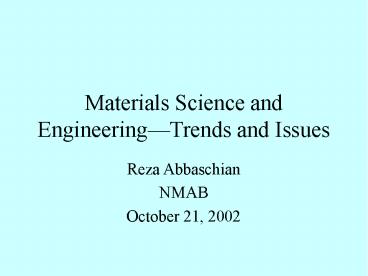Materials Science and Engineering - PowerPoint PPT Presentation
Title:
Materials Science and Engineering
Description:
Materials Science and Engineering Trends and Issues Reza Abbaschian NMAB October 21, 2002 Outline Educational Trends and Issues Structural Trends and Issues ... – PowerPoint PPT presentation
Number of Views:1003
Avg rating:3.0/5.0
Title: Materials Science and Engineering
1
Materials Science and EngineeringTrends and
Issues
- Reza Abbaschian
- NMAB
- October 21, 2002
2
Outline
- Educational Trends and Issues
- Structural Trends and Issues
- Splintered Professional Certification
- Incoherent professional Representation
- Reduced Core Funding(e.g. DOE)
- Blurred Boundaries
3
Core elements of Materials Science and Engineering
Source Materials Science and Engineering for the
1990s, NRC, 1989
4
Materials Science and Engineering Core, including
the end-user
Source Materials science and engineeringforging
stronger links to users, NRC 1999
5
BROADENING OF MATERIAL FIELD
Empirical knowledge and Societal Needs
Materials Science and Engineering
Basic Sciences and engineering
Educational Challenges Integrated
Education Balanced Science and Engineering
Education
6
Undergraduate CurriculaBased on 11 departments
- Science topics 28-37 credits, average 33
- Humanities 31-37, average 24
- Engineering 13-19, average 16
- Materials 27-53, average 37
- Tech Electives 8-24, average 11
- Free Electives 0-15
- Specialization yes and no
7
Core Topics for MSE Curriculum
- Introduction to Materials
- Experimental Techniques
- Thermodynamics
- Transport Properties
- Phase Equilibria
- Phase Transformation
- Kinetics
- Structure
- Characterization
- Mechanical Behavior
- Electronic, Magnetic, and Optical Behavior
- Synthesis, Processing, and Manufacturing
- Materials Selection and Design
- Failure Analysis
8
UNDERGRADUATE EDUCATION
Basic Sciences Basic Engineering Materials Core
(Processing-Properties-Structure-Applications of
All Materials)
Specialization
Materials Science and Engineering
Processing
Properties
Materials Science and Engineering
Structure
Applications
Ceramics
Electronics
Polymers
Metals
Horizontal Integration
Synthesis-Processing-Manufacturing continuum
9
MATRIX COVERAGE OF MATERIALS SCIENCE AND
ENGINEERING (UF Model)
Energetics/Kinetics
Transformations
Stability
2 courses Research/Design
Characterization
Selection/Failure
Intro Materials
Mechanical Behavior
6 - 9 Hours Electives
Mats Lab
10
Curricula have become shorter as universities
have been forced to reduce B.S. degrees to a
maximum of 128 credits. At the same time, the
topic matter has broadened with the introduction
of coursework on all classes of materials. Thus,
subjects common in the 1960s are often missing
from MSE and Metallurgical curricula today.
Analytical Chemistry Physical Chemistry Statistics
Static Strength of Materials Mass and Energy
Balances Deformation Processing Joining Melting
and Refining Thermal Processing
The larger departments can afford to offer many
courses as electives and have enough students to
justify them. Smaller departments cannot.
11
Source ASEE Engineering Statistics 2001
12
Source ASEE Engineering Statistics 2001
13
Source ASEE Engineering Statistics 2001
14
Source ASEE Engineering Statistics 2001
15
Source ASEE Engineering Statistics 2001
16
Source ASEE Engineering Statistics 2001
17
(No Transcript)
18
(No Transcript)
19
(No Transcript)
20
Materials Programs offering Undergraduate
Education Total Programs 69 Degree
titlesMetallurgical Engineering
11Metallurgical and Materials Engr.
5Materials Engineering 12Materials
Science 4 Materials Science and Mineral
Engr. 1Materials Science and
Engineering 25Materials Option under Chemical
Engr. 4Materials Option under Mechanical
Engr. 5Ceramic Engineering 7Polymer
Science Engr. 4
21
Faculty size
Average
Source UMC
Faculty Head Count Average of 107
Departments 16.4 in 1993 vs 18.3 in 2000 Source
ASM Education yearbook, 1993 and 2000
22
Source ASEE Engineering Statistics 2001
23
(No Transcript)
24
Source ASEE Engineering Statistics 2001
25
(No Transcript)
26
Consolidation of Departments
- Between 1993 and 2000, fifteen departments out of
107 in North America were merged or consumed by
other departments. Examples - Mat Sci and Eng Chemical Materials Eng
- Interdisciplinary Program
- Chemical
Biochem Eng - Mat Engineering Mech Mat Eng
- Met Mat Eng Mech, Mat Aero Eng
- Source ASM Education Yearbook, 1993 and 2000
27
Trends in ABET Accreditation Ceramic Programs
28
Diversity and Trends in ABET Accreditation Metallu
rgy Materials Programs
((In comparison, over 99 of around 230 ME
departments are accredited in Mech Eng.))
29
MULTIDISCIPLINARY RESEARCH APPROACH
AEMES, Civil, Electrical Mechanical Engineering
Chemical Engineering, Dental
Physics, Electrical Engineering
Chemistry, Medical
30
Source ASEE Engineering Statistics 2001
31
(No Transcript)
32
Academic Research ObligationsFY 1999
Source Science Engineering Indicators-2002
33
Source Science Engineering Indicators-2002
34
(No Transcript)
35
(No Transcript)
36
(No Transcript)
37
MSE Employment Profile(all degrees) Data based on
620 UF-MSE graduates
38
(No Transcript)
39
(No Transcript)
40
(No Transcript)
41
(No Transcript)
42
Source Occupational Outlook, Bureau of Labor
Statistics, 2002-2003
43
Source Occupational Outlook, Bureau of Labor
Statistics, 2002-2003
44
(No Transcript)
45
(No Transcript)

